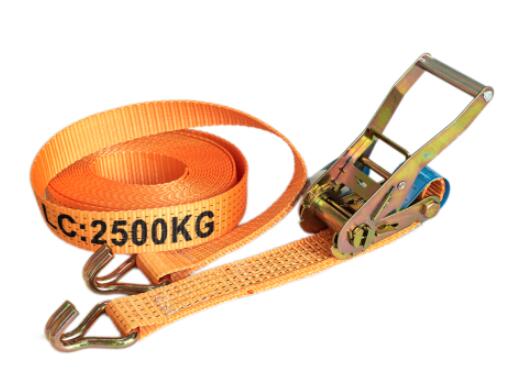Release time: Sep. 13, 2024
Ratchet straps are essential tools for securing cargo during transport, and their durability is crucial to ensuring both safety and reliability. However, like any equipment exposed to wear and tear, ratchet straps have a limited lifespan. The longevity of these straps can vary depending on several factors, including material quality, frequency of use, and environmental conditions. This article will explore the factors that impact the lifespan of ratchet straps and provide tips for prolonging their usability.

The lifespan of ratchet straps is determined by several key factors. While some straps may last for years, others can deteriorate more quickly if exposed to harsh conditions. Here are the primary considerations that affect how long a ratchet strap can last:
1. Quality of Materials:
The quality of materials used in manufacturing plays a significant role in the lifespan of ratchet straps. Straps made from high-grade polyester or nylon are more resistant to wear and tear. Cheap or low-quality straps may degrade faster, especially if they are frequently exposed to the elements.
2. Frequency of Use:
How often you use ratchet straps directly impacts their longevity. Regular use, especially for heavy-duty applications, can cause the straps to weaken over time. If a strap is used daily, it will wear out more quickly than one that is only used occasionally.
3. Environmental Exposure:
Exposure to extreme temperatures, UV radiation, moisture, and chemicals can drastically reduce the life of ratchet straps. UV rays from the sun can weaken the webbing, while moisture can lead to mould, mildew, and eventual rot. In colder climates, freezing and thawing cycles can cause the straps to become brittle, increasing the risk of breakage.
4. Load Capacity:
Every ratchet strap has a specific working load limit (WLL) and breaking strength. Consistently using straps near or above their WLL can shorten their lifespan. Overloading the straps can result in fraying, tearing, or even complete failure of the strap under pressure.
Ratchet straps should be regularly inspected for signs of damage. Failing to replace worn-out straps could lead to accidents or cargo loss. Here are the warning signs that it might be time to replace your ratchet straps:
1. Fraying or Cuts in the Webbing:
One of the most common signs of wear is fraying or cuts in the strap's webbing. Even small cuts can compromise the strap's integrity, reducing its ability to secure loads safely.
2. Mould or Mildew Growth:
If ratchet straps are exposed to moisture, they can develop mould or mildew. While some minor mould can be cleaned off, excessive growth can weaken the strap material, making it unsafe for use.
3. Discolouration from Sun Damage:
Straps that have been exposed to UV rays for extended periods may fade or become discoloured. This discolouration is an indication that the webbing has weakened and is more prone to breaking under stress.
4. Corrosion on Metal Components:
Inspect the ratchet mechanism and hooks for signs of rust or corrosion. Metal components can deteriorate over time, making it difficult to properly tighten or release the straps. This can also lead to a loss of tension during transport.
To extend the lifespan of your ratchet straps, proper care and maintenance are essential. Here are some tips to help you get the most out of your straps:
1. Store Them Properly:
When not in use, store your ratchet straps in a dry, cool place away from direct sunlight. Storing them in a sealed container or bag can protect them from moisture and UV exposure.
2. Clean Them Regularly:
Dirt, grime, and chemicals can accumulate on the straps, causing them to wear out faster. Clean your ratchet straps with mild soap and water, and allow them to dry completely before storing them.
3. Inspect Before Every Use:
Make it a habit to inspect your ratchet straps before each use. Look for any signs of wear, including fraying, cuts, or damage to the ratchet mechanism. If any defects are found, replace the strap immediately.
4. Avoid Overloading the Straps:
Always use ratchet straps within their designated working load limit. Avoid overloading them to prevent excess strain on the webbing and hardware.
There is no definitive answer for how long a ratchet strap will last, as it depends on the factors mentioned above. However, under normal usage conditions, a well-maintained ratchet strap can last anywhere from 1 to 5 years. Straps that are heavily used or exposed to harsh environmental conditions may need to be replaced more frequently. Regular inspections and proper maintenance are key to ensuring their safety and longevity.
Ratchet straps are vital tools for securing cargo, and their durability is essential to maintaining safety during transport. By paying attention to the quality of materials, frequency of use, and environmental conditions, you can get the most out of your ratchet straps. If you notice any signs of wear, such as fraying or corrosion, it's time to replace them. For more information or to purchase high-quality ratchet straps, contact us today. As a trusted supplier, we offer a wide selection of durable and reliable cargo securing equipment to meet your needs.